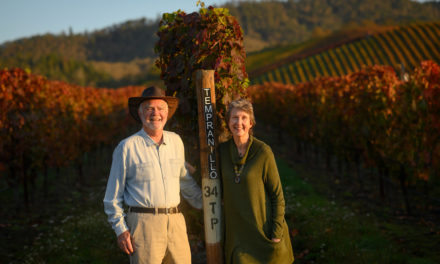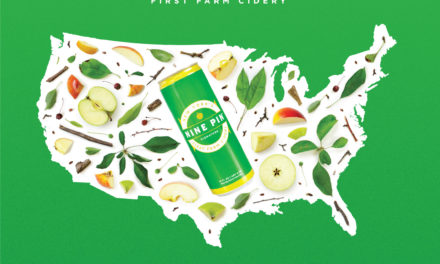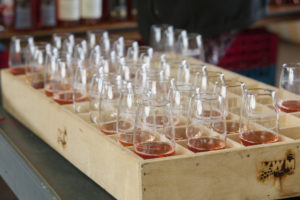 The rosé wine category has been growing steadily for more than a decade and shows no sign of slowing down. Once considered just a midsummer’s dream, it’s now produced in sufficient quantity to supply enthusiasts’ needs year-round.
The rosé wine category has been growing steadily for more than a decade and shows no sign of slowing down. Once considered just a midsummer’s dream, it’s now produced in sufficient quantity to supply enthusiasts’ needs year-round.
The United States is currently the third largest producer of rosé wines, with the premium dry rosé category today outpacing every other industry segment, save the ubiquitous red blend. In fact, the two often go hand-in-hand. Producers often seek to concentrate their table reds by bleeding the fully ripened grapes off before fermentation—the French call this method saignée—creating another wine product, generally lighter in color and body than a typical red, that can be bottled and sold as rosé. Most U.S. rosés are made using saignée, which tends to yield a wine that’s quite fruit-forward and fairly high in alcohol, usually exceeding 13.5 percent. In contrast, in Provence, France, grapes are typically picked quite low in sugar and direct-pressed to make lighter hued, less fruity, more complex rosés, typically well below 13 percent alcohol (most Provencal rosés are 12 percent or less).
Some U.S. winemakers prefer to make “intentional rosé,” choosing a grape variety such as Grenache, Carignane, or Counoise, which can be purchased relatively cheaply (compared to Pinot Noir) and made into a refreshingly tart beverage that can sell for less than $25. Hint: always check the ABV on the label. If you like rosés with big acid and bright spice, make sure they’re below 13 percent; if you prefer more ripe, sweet fruit, look for those 14 percent and above.
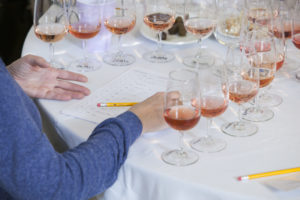
Competition Crowns Winners
Now in its fifth year and growing along with the popularity of its rosey-hued focal point, the 2018 Experience Rosé Competition, produced by Wine Competitions Management & Productions, took place April 18 at Soda Rock Winery in the heart of California’s Alexander Valley. Originally called Rosé Today, the competition was conceived by Craig Palmer and Alan Habel, who share a deep appreciation for rosés. They created the tagline “Because every day pairs better with rosé,” to emphasize the concept of rosé wines as an integral part of the wine drinking experience.
“That’s the idea that attracted us so irresistibly to this lifestyle concept of Experience Rosé,” says Palmer, who produces this event, as well as others (also rosé centric) throughout the year. “So many everyday opportunities become more colorful paired with this infinitely elegant and exuberant wine.”
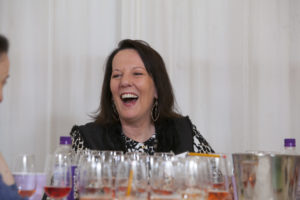 With more than 300 entries from across the nation and around the world, the 2018 competition pulled in an outstanding breadth of rosés in every possible hue, from the faintest blush to cherry red runway lipstick. A panel of 10 top-tier judges sought out the very best in dry, sparkling and sweet categories – all of which represented a wide range of rosé winemaking styles.
With more than 300 entries from across the nation and around the world, the 2018 competition pulled in an outstanding breadth of rosés in every possible hue, from the faintest blush to cherry red runway lipstick. A panel of 10 top-tier judges sought out the very best in dry, sparkling and sweet categories – all of which represented a wide range of rosé winemaking styles.
We tasted pale salmon chiffon pretties from Provence, cherry bursts of sweetness from Canada, a bevvy of dashing Chambourcins from Illinois and Virginia, a gorgeous Grenache rosé from Oregon’s Umpqua Valley, a spritely Frontenac Gris sparkling from the Leelanau Peninsula of Michigan, an impressive Pinotage from the Sonoma Coast, and a fetchingly dessicating Bobal sparkling from Spain.
Our domestic hybrids and natives stack up nicely to all those imports, such as Pinot Noir, Sangiovese, and Grenache. We even had a couple of notable rosés of Cabernet Sauvignon and a Cab Franc or two, along with Petit Verdot. Paso Robles, Calif., trotted out an impressive lot of Rhone editions, while Livermore, Calif., fired on all cylinders with primarily Bordeaux and Grenache-based beauties, with nearly all their entries winning gold.
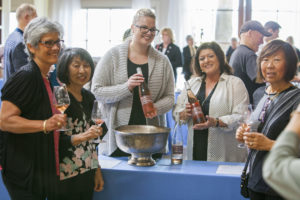 Five Best of Show awards, 10 Best of Class designations, 15 double gold, and 79 gold medals were bestowed on this year’s entries. What’s most remarkable are the price points for the Best of Show winners, all but one of which came in at less than $20—certainly a boon for those who intend to live up to the competition’s motto, because wallet-friendly wines pair best of all.
Five Best of Show awards, 10 Best of Class designations, 15 double gold, and 79 gold medals were bestowed on this year’s entries. What’s most remarkable are the price points for the Best of Show winners, all but one of which came in at less than $20—certainly a boon for those who intend to live up to the competition’s motto, because wallet-friendly wines pair best of all.
Tasting Notes
Best of Show and Best Domestic Dry: 2017 Draxton Pinot Meunier Rosé, Napa Valley, $18
Alluring tea rose notes comingled with cherry pie and fresh strawberries, showing a deft texture and full-on silky, light-on-its-feet experience from one end of the palate to the other. Flows like a ballroom dance. Definitely could drink this all day. Awarded 100 points.
Best Domestic Sparkling: NV Domaine Laurier Brut Rosé, California, méthode champenoise
Solid, finely bubbled sparkler with cran-pom core and plenty of uplift. From Bronco Wine Company. (97 points)
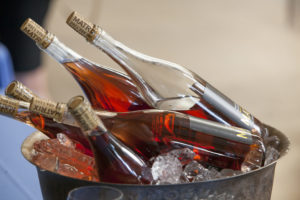 Best Domestic Sweet: NV Penns Woods Winery Moscato Rosé, Pennsylvania
Best Domestic Sweet: NV Penns Woods Winery Moscato Rosé, Pennsylvania
This tastes like a summer day at your favorite county fair, brimming over with sweet strawberries, cotton candy, and pink raspberry lemonade, with the bubbly personality of Moscato and a touch of Merlot (10%) to give it a summer pink hue. (96 points)
Best International Dry: 2017 Marquis de Goulaine Rosé d’Anjou
What you dream about in a Provence rosé: floral and light as a spring morning, showing fresh fruit but also lots of savory notes. Dry, with a complexity that adds length. Made from 60% Cabernet Franc, 20% Grolleau, and 20% Gamay. (100 points)
Best International Sparkling: NV Tarantas Sparkling Rosé, Valencia DO
Super dry with galvanizing citrus notes along with dried strawberries and red currants. Made from organically grown Bobal grapes. (95 points)
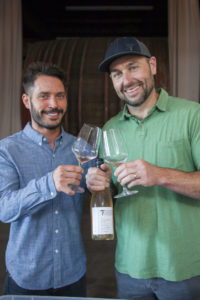
A few more standouts
Among my personal favorites was a wild-ass and utterly captivating blend of Chardonnay, Marechal Foch, Traminette, Gewurztraminer, and Frontenac Gris that my panel awarded 97 points. It hinted of sweetness, with driving flavors of watermelon and cinnamon spice that reminded me of Good Earth tea. It’s nice to relive those memories of the ’80s. (2017 Captains Walk Winery, 7 Seas, America)
We also delighted in the 2017 Nichelini Family Winery Rosé of Cabernet Sauvignon from Napa Valley, which was a really cool mix of herbs and cherry candy, showing grilled plum and olive tapenade on the palate, with good weight and a memorably classy delivery. It was awarded 98 points and Best of Class, Napa Valley.
Another solid performer from our panel was the 2017 Castle Rock Rosé of Pinot Noir from Anderson Valley (Mendocino County) that oozed cherry pie and cherry candy aromas, serving up copious pomegranate and cherry pop tart, along with a hint of umami that led us to conclude it would be great with Asian food. It received 97 points and a Best of Class.
 It’s a good time to stock up on what is fast becoming America’s pink obsession. There’s plenty of bang for the buck in this category!
It’s a good time to stock up on what is fast becoming America’s pink obsession. There’s plenty of bang for the buck in this category!
To see a complete list of winners, visit rosewinetoday.com.
Experience Rosé is proud to thank its presenting sponsor, Bank of Marin, and hosting sponsors Soda Rock Winery, Sonoma magazine, Spirited magazine, and Hangar 1 Vodka.




































